#concretist
Text
Mature white girl gives BBC blowjob
Les gets her ass fisted
Una chupadita (me vengo en su cara)
Fat white bitch sucks dick
Thot in Texas Thin thot skinny bath butt unicorn bathing bbc creampie white
Cogiendome a Mexicana Madura
جنس مغربية مع خليجي (حرام عليك كسي يوجعني
Masturbando para mi novio
Hood gay boys sex and tall men with dwarfs porn first time Timmy Pig
Multi hand choke
#vice-protector#shelvier#erucivorous#scutcheonless#twelve-year#nonoppressively#unbudgeably#Flexography#thiazols#mussed#pleuritic#sea-gull#concretist#calymma#Chindit#Phoenix#approval#joys#antiparliamentarist#supergenerous
0 notes
Text
Like flames suddenly flaring up, these thoughts darted through my mind. Much later, when I reflected upon Freud's character, they revealed their significance. There was one characteristic of his that preoccupied me above all: his bitterness. It had struck me at our first encounter, but it remained inexplicable to me until I was able to see it in connection with his attitude toward sexuality. Although, for Freud, sexuality was undoubtedly a numinosum, his terminology and theory seemed to define it exclusively as a biological function. It was only the emotionality with which he spoke of it that revealed the deeper elements reverberating within him. Basically, he wanted to teach-or so at least it seemed to me-that, regarded from within, sexuality included spirituality and had an intrinsic meaning. But his concretistic terminology was too narrow to express this idea. He gave me the impression that at bottom he was working against his own goal and against himself; and there is, after all, no harsher bitterness than that of a person who is his own worst enemy. In his own words, he felt himself menaced by a "black tide of mud?”-he who more than anyone else had tried to let down his buckets into those black depths.
Freud never asked himself why he was compelled to talk continually of sex, why this idea had taken such possession of him. He remained unaware that his "monotony of interpretation" expressed a flight from himself, or from that other side of him which might perhaps be called mystical. So long as he refused to acknowledge that side, he could never be reconciled with himself. He was blind toward the paradox and ambiguity of the contents of the unconscious, and did not know that everything which arises out of the unconscious has a top and a bottom, an inside and an outside. When we speak of the outside-and that is what Freud did- we are considering only half of the whole, with the result that a countereffect arises out of the unconscious.
There was nothing to be done about this one-sidedness of Freud's. Perhaps some inner experience of his own might have opened his eyes; but then his intellect would have reduced any such experience to "mere sexuality" or "psychosexuality." He remained the victim of the one aspect he could recognize, and for that reason I see him as a tragic figure; for he was a great man, and what is more, a man in the grip of his daimon.
memories, dreams, reflections by c.g. jung
6 notes
·
View notes
Text
Thinking In The Extraverted Attitude
As a result of the general attitude of extraversion, thinking is orientated by the object and objective data. This orientation of thinking produces a noticeable peculiarity.
As a result of the general attitude of extraversion, thinking is orientated by the object and objective data. This orientation of thinking produces a noticeable peculiarity.
Extraverted thinking is conditioned in a larger measure by these latter factors than by the former. judgment always presupposes a criterion ; for the extraverted judgment, the valid and determining criterion is the standard taken from objective conditions, no matter whether this be directly represented by an objectively perceptible fact, or expressed in an objective idea ; for an objective idea, even when subjectively sanctioned, is equally external and objective in origin. Extraverted thinking, therefore, need not necessarily be a merely concretistic thinking it may equally well be a purely ideal thinking, if, for instance, it can be shown that the ideas with which it is engaged are to a great extent borrowed from without, i.e. are transmitted by tradition and education. The criterion of judgment, therefore, as to whether or no a thinking is extraverted, hangs directly upon the question: by which standard is its judgment governed—is it furnished from without, or is its origin subjective? A further criterion is afforded by the direction of the thinker’s conclusion, namely, whether or no the thinking has a preferential direction outwards. It is no proof of its extraverted nature that it is preoccupied with concrete objects, since I may be engaging my thoughts with a concrete object, either because I am abstracting my thought from it or because I am concretizing my thought with it. Even if I engage my thinking with concrete things, and to that extent could be described as extraverted, it yet remains both questionable and characteristic as regards the direction my thinking will take; namely, whether in its further course it leads back again to objective data, external facts, and generally accepted ideas, or not. So far as the practical thinking of the merchant, the engineer, or the natural science pioneer is concerned, the objective direction is at once manifest. But in the case of a philosopher it is open to doubt, whenever the course of his thinking is directed towards ideas. In such a case, before deciding, we must further enquire whether these ideas are mere abstractions from objective experience, in which case they would merely represent higher collective concepts, comprising a sum of objective facts ; or whether (if they are clearly not abstractions from immediate experience) they may not be derived from tradition or borrowed from the intellectual atmosphere of the time. In the latter event, such ideas must also belong to the category of objective data, in which case this thinking should also be called extraverted.
Although I do not propose to present the nature of introverted thinking at this point, reserving it for a later section, it is, however, essential that I should make a few statements about it before going further. For if one considers strictly what I have just said concerning extraverted thinking, one might easily conclude that such a statement includes everything that is generally understood as thinking. It might indeed be argued that a thinking whose aim is concerned neither with objective facts nor with general ideas scarcely merits the name ‘thinking’. I am fully aware of the fact that the thought of our age, in common with its most eminent representatives, knows and acknowledges only the extraverted type of thinking. This is partly due to the fact that all thinking which attains visible form upon the world’s surface, whether as science, philosophy, or even art, either proceeds direct from objects or flows into general ideas. On either ground, although not always completely evident it at least appears essentially intelligible, and therefore relatively valid. In this sense it might be said that the extraverted intellect, i.e. the mind that is orientated by objective data, is actually the only one recognized.
There is also, however—and now I come to the question of the introverted intellect—an entirely different kind of thinking, to which the term I “thinking” can hardly be denied: it is a kind that is neither orientated by the immediate objective experience nor is it concerned with general and objectively derived ideas. I reach this other kind of thinking in the following way. When my thoughts are engaged with a concrete object or general idea in such a way that the course of my thinking eventually leads me back again to my object, this intellectual process is not the only psychic proceeding taking place in me at the moment. I will disregard all those possible sensations and feelings which become noticeable as a more or less disturbing accompaniment to my train of thought, merely emphasizing the fact that this very thinking process which proceeds from objective data and strives again towards the object stands also in a constant relation to the subject. This relation is a condition sine qua non, without which no thinking process whatsoever could take place. Even though my thinking process is directed, as far as possible, towards objective data, nevertheless it is my subjective process, and it can neither escape the subjective admixture nor yet dispense with it. Although I try my utmost to give a completely objective direction to my train of thought, even then I cannot exclude the parallel subjective process with its all-embracing participation, without extinguishing the very spark of life from my thought. This parallel subjective process has a natural tendency, only relatively avoidable, to subjectify objective facts, i.e. to assimilate them to the subject.
Whenever the chief value is given to the subjective process, that other kind of thinking arises which stands opposed to extraverted thinking, namely, that purely subjective orientation of thought which I have termed introverted. A thinking arises from this other orientation that is neither determined by objective facts nor directed towards objective data—a thinking, therefore, that proceeds from subjective data and is directed towards subjective ideas or facts of a subjective character. I do not wish to enter more fully into this kind of thinking here; I have merely established its existence for the purpose of giving a necessary complement to the extraverted thinking process, whose nature is thus brought to a clearer focus.
When the objective orientation receives a certain predominance, the thinking is extraverted. This circumstance changes nothing as regards the logic of thought—it merely determines that difference between thinkers which James regards as a matter of temperament. The orientation towards the object, as already explained, makes no essential change in the thinking function; only its appearance is altered. Since it is governed by objective data, it has the appearance of being captivated by the object, as though without the external orientation it simply could not exist. Almost it seems as though it were a sequence of external facts, or as though it could reach its highest point only when chiming in with some generally valid idea. It seems constantly to be affected by objective data, drawing only those conclusions which substantially agree with these. Thus it gives one the impression of a certain lack of freedom, of occasional short-sightedness, in spite of every kind of adroitness within the objectively circumscribed area. What I am now describing is merely the impression this sort of thinking makes upon the observer, who must himself already have a different standpoint, or it would be quite impossible for him to observe the phenomenon of extraverted thinking. As a result of his different standpoint he merely sees its aspect, not its nature; whereas the man who himself possesses this type of thinking is able to seize its nature, while its aspect escapes him. judgment made upon appearance only cannot be fair to the essence of the thing—hence the result is depreciatory. But essentially this thinking is no less fruitful and creative than introverted thinking, only its powers are in the service of other ends. This difference is perceived most clearly when extraverted thinking is engaged upon material, which is specifically an object of the subjectively orientated thinking. This happens, for instance, when a subjective conviction is interpreted analytically from objective facts or is regarded as a product or derivative of objective ideas. But, for our ‘scientifically’ orientated consciousness, the difference between the two modes of thinking becomes still more obvious when the subjectively orientated thinking makes an attempt to bring objective data into connections not objectively given, i.e. to subordinate them to a subjective idea. Either senses the other as an encroachment, and hence a sort of shadow effect is produced, wherein either type reveals to the other its least favourable aspect, The subjectively orientated thinking then appears quite arbitrary, while the extraverted thinking seems to have an incommensurability that is altogether dull and banal. Thus the two standpoints are incessantly at war.
Such a conflict, we might think, could be easily adjusted if only we clearly discriminated objects of a subjective from those of an objective nature. Unfortunately, however, such a discrimination is a matter of impossibility, although not a few have attempted it. Even if such a separation were possible, it would be a very disastrous proceeding, since in themselves both orientations are one-sided, with a definitely restricted validity; hence they both require this mutual correction. Thought is at once sterilized, whenever thinking is brought, to any great extent, under the influence of objective data, since it becomes degraded into a mere appendage of objective facts; in which case, it is no longer able to free itself from objective data for the purpose of establishing an abstract idea. The process of thought is reduced to mere ‘reflection’, not in the sense of ‘meditation’, but in the sense of a mere imitation that makes no essential affirmation beyond what was already visibly and immediately present in the objective data. Such a thinking-process leads naturally and directly back to the objective fact, but never beyond it ; not once, therefore, can it lead to the coupling of experience with an objective idea. And, vice versa, when this thinking has an objective idea for its object, it is quite unable to grasp the practical individual experience, but persists in a more or less tautological position. The materialistic mentality presents a magnificent example of this.
When, as the result of a reinforced objective determination, extraverted thinking is subordinated to objective data, it entirely loses itself, on the one hand, in the individual experience, and proceeds to amass an accumulation of undigested empirical material. The oppressive mass of more or less disconnected individual experiences produces a state of intellectual dissociation, which, on the other hand, usually demands a psychological compensation. This must consist in an idea, just as simple as it is universal, which shall give coherence to the heaped-up but intrinsically disconnected whole, or at least it should provide an inkling of such a connection. Such ideas as “matter” or “energy” are suitable for this purpose. But, whenever thinking primarily depends not so much upon external facts as upon an accepted or secondhand idea, the very poverty of the idea provokes a compensation in the form of a still more impressive accumulation of facts, which assume a one-sided grouping in keeping with the relatively restricted and sterile point of view; whereupon many valuable and sensible aspects of things automatically go by the board. The vertiginous abundance of the socalled scientific literature of today owes a deplorably high percentage of its existence to this misorientation.
Source: Psychological Types
#personality theory#personality types#typology#cognitive functions#jung#jungian typology#et#te#et(n)#et(s)#entj#estj
1 note
·
View note
Text
Lauand, the only woman in the pioneering Grupo Ruptura, made sparse compositions where geometric rigor worked in service of celebrating straight lines.
Born in Pontal in 1922, Lauand began her career during a period of economic prosperity in Brazil. The administration of President Juscelino Kubitschek initiated a massive urbanization project, including the construction of the new capital, Brasília. As expected, artists responded to the sudden societal shift with avant-garde forms of expression, embracing geometric abstraction that experimented in nontraditional materials and forwent the self-seriousness of their North American contemporaries.
0 notes
Text
A.B. If the unconscious presents itself on the whole as a text object, to preserve your concretist [chosiste] perspective,
in which the message is discovered as always adhering to a code
so that there is no general code within which the message might disclose its meaning in an a priori fashion, as it were
then
a psychology cannot be a general science: it never deals with anything but texts that are radically singular, being the bearers of their own specific code
and psychology is, therefore, a science of the individual, not only by virtue of its object but ultimately by virtue of its method
Or is there a general hermeneutic?
M.F. One needs to distinguish, in this instance and elsewhere, between
the general
the absolute
1. There is no absolute hermeneutic, in the sense that
[on one hand] one can never be sure that one has obtained the final text, that what one has obtained doesn't mean something else behind what it means.
and one can never be sure, on the other hand, of doing an absolute linguistics
So, whatever the approach, one is never sure of reaching
either the absolutely general form
the absolutely primary text
2. That being said, I still think that there are relatively large generalized structures, and that, for example, there may be among several individuals a certain number of identical processes [procedes] that may be encountered in all of them alike; and there is no reason why structures you have discovered for one would not apply to the other.
– Michel Foucault, Philosophy and Psychology, this interview conducted by Alain Badiou, appeared in Dossiers pedagogiques de la radio-television scolaire (27 Feb. 1965), pp. 65-71. Robert Hurley's translation.
1 note
·
View note
Photo

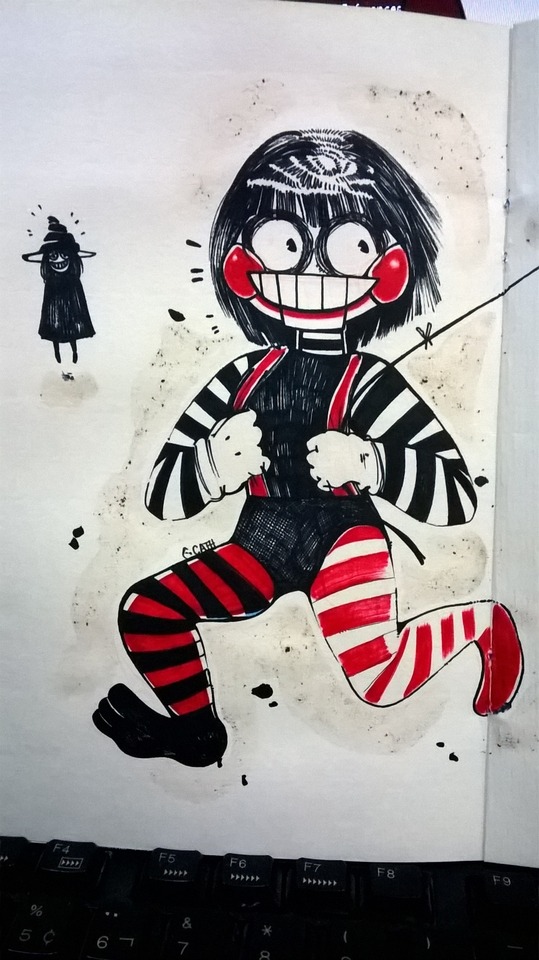

Inktober Days 13-14/31 - Tomb Stones, the Witchmaker and Kan-Kan, the Concretist Wizard
#artists on tumblr#inktober#inktober2017#doodle#yay#halloween#day13#day14#wizard#concrete#concretist#fox#witchmaker#cute#kawaii#magic fox
27 notes
·
View notes
Photo

Paul Gadegaard (Nov. 17, 1920 - 1996) was a Danish Concretist artist, who did workplace art installations for a number of Danish factories in the post-War era. He used bright colors that came ‘off the wall’ and onto furniture, floors and workbenches, creating a three-dimensional work the people moved about and worked in.
Gadegaard studied at the Danish Academy during WWII and had to flee to Sweden for his Resistance activities in 1944. Immediately after the War he went to Paris to study with André Lhote and he exhibited with Denise René’s gallery. He joined the artists’ group Linien II in 1949.
Above: Composition, 1964 (heart, Herning)
#art#danish artist#paul gadegaarrd#1960s#royal danish academy#concretism#color field#andré lhote#galerie denise rené#linien ii#heart herning#angli#danish resistance#wwii
3 notes
·
View notes
Photo

Judith Lauand The tumultuous historical and artistic events that marked the art scene in Brazil during the 1950s can be understood through the work of a particular artist: Judith Lauand. The artist was born in Pontal, São Paulo, in 1922. Lauand produced over one hundred works between 1950 and 1959, a crucial period in the development in her artistic career. Paintings, drawings, gouaches, tapestries, woodcuts, woodcut woodblock and sketches on several types of paper, photographs, notebooks, catalogs and other material that constituted a body of work which not only showed her Concretist production but also her artistic process and the stylistic transformations that her work underwent through that decade. Lauand’s prolific artistic journey took her through academic painting, figurative expressionism, lyrical abstraction, and, finally, concrete art, in which she established her artistic identity. But despite being framed by concrete art, her work is unique for the subtle and feminine manner with which she approaches the rational, mathematical, and formal rigour of her compositions. #neonurchin #neonurchinblog #dedicatedtothethingswelove #suzyurchin #ollyurchin #art #music #photography #fashion #film #words #pictures #neon #urchin #escoladebelasartes #sãopaulo #paintings #drawings #gouaches #tapestries #woodcuts #gruporuptura #concreteart #ladyofconcreteart #judithlauand (at Brazil) https://www.instagram.com/p/CQseYoalHlH/?utm_medium=tumblr
#neonurchin#neonurchinblog#dedicatedtothethingswelove#suzyurchin#ollyurchin#art#music#photography#fashion#film#words#pictures#neon#urchin#escoladebelasartes#sãopaulo#paintings#drawings#gouaches#tapestries#woodcuts#gruporuptura#concreteart#ladyofconcreteart#judithlauand
4 notes
·
View notes
Photo
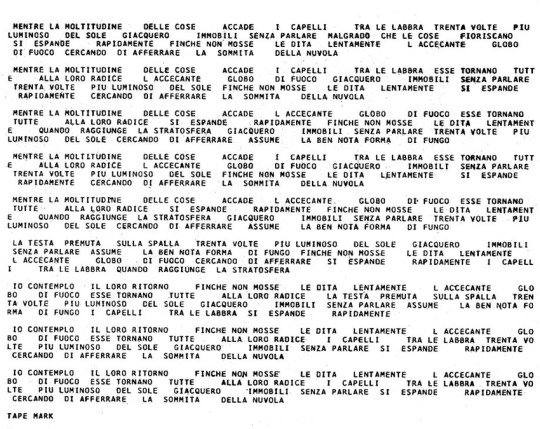
Nanni Balestrini, Tape Mark I, 1961.
Nanni Balestrini is also a concretist poet (Balestrini, 1963: 195-205).17 His Tape Mark I (October 1961) (Balestrini, 1961: 145-151)18 is a “derivative” text, generated from a selection of passages from three preexisting narrative works belonging to different genres: Hiroshima Diary by Michihito Hachiya, The Mystery of the Elevator by Paul Goldwin and the Tao Te Ching by Lao Tzu. The preexisting linguistic materials were first broken down into minimal units and then recomposed in a preordinate collage. This is shown in the instructions given with the program (146-149). In the foreword, Balestrini wrote:
The problem posed was not about obtaining from the machine an imitation of pro-cesses peculiar to humans. It was simply about exploiting the abilities of the electronic means to resolve, very fast, certain complex operations pertaining to poetic technique. The usefulness of, and the legitimate resort to, the methods and means made available by science and by the most advanced technologies, intended as an integration of the literary and artistic creative work, become manifest insofar as we belong to an industrial civilization. (145)
Bense himself knew about Balestrini’s experiments, but remarked that they were of limited complexity, because programming techniques diminished the heuristic value of the process, alien to the paradigms of the information theory:
In 1963, Nanni Balestrini published in his Come si agisce machine-generated artificial texts that were not really developed as Shannon’s approximations; on the contrary, they were programmed via an IBM 7070 into 1200 orders relative to combinations of 10 pre-given elements according to syntax rules. (Bense, 1967/68: 21)
There is an affinity between Lutz’s ‘stochastic’ texts and Balestrini’s Tape Mark I, in the sense that they are both derivative works: “Here the basic principle is to take an existing line or poem and alter it in some systematic way.”20 The specificity of this approach was determined later, when it became necessary to differentiate between that form of derivation and other types of texts, of ‘formulary’ nature: “Formulary poems consist of strings of sentences generated by means of a formula or syntactic rule” (Franke 1971: 51).
Considering that the former derivative texts require literary skills and sensibility, we understand why Lutz did not continue his experiments.
In these textual devices, the most relevant aspect is the reaffirmation of the role of the author as the one responsible for the evaluation of the materials processed and their final selection. In other words, here the author acts as writer/reader, or ‘wreader.’
The Early Computer Poetry and Concrete Poetry. Matteo D’Ambrosio
21 notes
·
View notes
Photo
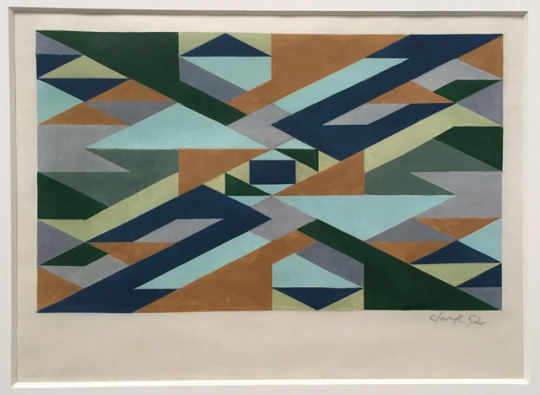
Lygia Clark at Luhring Augustine Gallery
Iconic Brazilian Neo-Concretist Lygia Clark explored the experience of space in both two and three dimensions, in paintings and her famous bicho (critter) sculptures that could be handled and manipulated. At Luhring Augustine Gallery in Chelsea, 2-D pieces, like this study for a modulated surface, suggests the organic world with tones that allude to earth and sky. (On view through June 17th). Lygia Clark, Estudio para Planos em superficie modulada (Study for Planes in modulated surface), gouache on cardboard, paper: 9 7/8 x 13 3/8 inches, 1952.
#lygia clark#neo-concretist#luhring augustine#goauche#painting#modern#geometric#abstract#nature#chelsea#tour#art#gallery
2 notes
·
View notes
Photo

Geometry Transformations / Collections Grauwinkel and Velfl will introduce to two concepts of collecting on the basis of their mutual comparison. The profiles of the two collections share the subject of geometry and Concretist Art in general. The exposition runs until end of March: #GHMP Prague City Gallery. Curators: Hana Larvová, Ljuba Beránková. The exhibition presenting the profile of two significant #private_collections – one Czech and one German – and revolving around international #Concretist Art will explore most various forms of geometry. The joint exhibition platform will introduce to the most distinguished representatives of the given artistic tendency and will simultaneously provide an interesting space for pondering the connections and, on the contrary, differences found in the individual collecting strategies. The Berlin collector Siegfried Grauwinkel has been building his collection for more than three decades. From its originally wider concept, he gradually narrowed its scope to Concretist Art and geometric forms in general, which he is presently extending with examples of Fundamental and Radical Painting. The Czech collection of Miroslav Velfl, too, was initially of a different range; the collector, however, became in recent years exclusively focused on Constructivist tendencies in both Czech and foreign art dating to between 1960s and 1980s. #gosee (hier: Prague, Czech Republic) https://www.instagram.com/p/BqsFvTxF66Z/?utm_source=ig_tumblr_share&igshid=1jbfsdp0fj001
0 notes
Photo
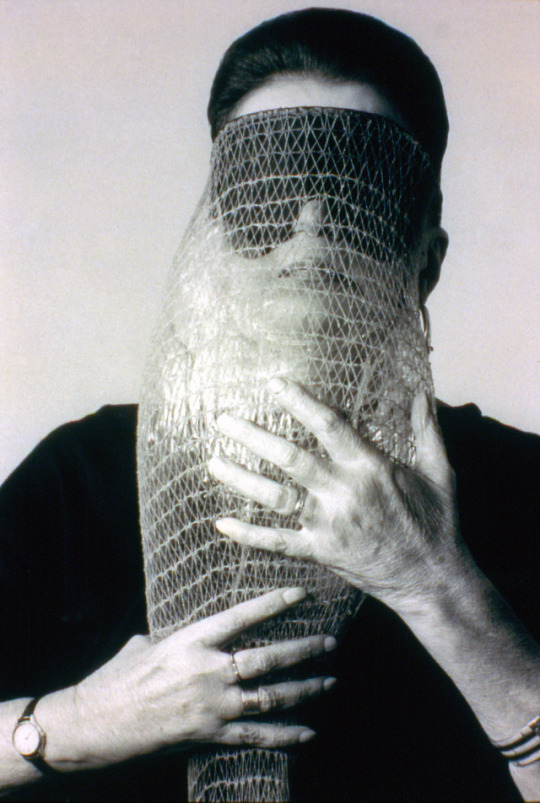
Lygia Clark, b. 1920, d. 1988
Abyssal mask with eye-patch / Máscara abismo com tapa-olhos
Brazil (1968)
Fabric, elastic bands, a nylon bag, and a stone
Photo by Sergio Gerardo Zalis, 1986
[Source]
Wikipedia says:
Lygia Clark was a Brazilian artist best known for her painting and installation work. She was often associated with the Brazilian Constructivist movements of the mid-20th century and the Tropicalia movement. Along with Brazilian artists Amilcar de Castro, Franz Weissmann, Lygia Pape and poet Ferreira Gullar, Clark co-founded the Neo-Concrete movement. The Neo-Concretists believed that art should be subjective and organic. Throughout her career, Clark discovered ways for museum goers (who would later be referred to as "participants") to interact with her art works. She sought to redefine the relationship between art and society. Clark's works dealt with inner life and feelings.
I’ve avoided posting about this incredibly important Brazilian artist for some time now, because she doesn’t seem to have created any self-portraits per se. But this is such an iconic image of her and her work that I felt this site wouldn’t be complete without it.
#Lygia Clark#brazil#south america#latin america#1960s#woman artist#wearable art#sculpture#mixed media
4 notes
·
View notes
Photo
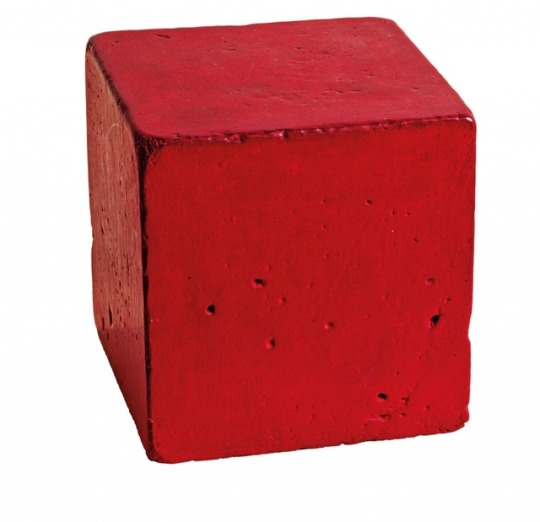
Aluísio Carvão (Brazilian, 1920–2001)
Cubocor (Color Cube), 1960
Pigment and oil on cement, 16.5 × 16.5 × 16.5 cm
Private Collection, Rio de Janeiro
© Haus der Kunst, Munich, Germany
Cubocor is the color red cast into a cube. Color as sculpture became an object for the viewer to confront, rather than merely the artist’s expressionistic tool. In this way Carvão integrated sculpture into its surrounding space, thereby creating an encounter with the viewer.
Aluísio Carvão, a founding member of the Rio de Janeiro–based neo-concrete group, wanted to involve the viewer in the work of art by having the object share space with its audience. The viewer was invited to have an individual response to the work. Concrete art, by contrast, assumed a general, universal, and rational audience whose experience was based on passive gazing. Carvão, like other neo-concretists, would go on to explore kinetic and auditory aspects of art via unconventional materials like nails, string, and bottle caps.
From 1957 to 1960, Carvão developed his “Cromáticas” (Cromatics), a series of paintings without frames. By removing these boundaries, Carvão reimagined the relationship of painting to wall as one of exchange, whereas his earlier concrete paintings explored geometric and color relationships within the defined space of the canvas. In 1960, Carvão shifted from painting to sculpture, as he was increasingly unsatisfied with the capacity of concrete painting to fully express the experience of color as a thing in itself.
#aluisio carvao#aluísio carvão#neo concrete movement#brazilian art#latin american art#art#sculpture#lamerican concretism#lamerican artinfo#mu art#mu sculp#mu#haus der kunst
2 notes
·
View notes
Link
A concrete decoration should be such that it becomes the envy of the neighborhood. The term “concretist” refers to “one who practices concrete poetry,”
0 notes
Photo
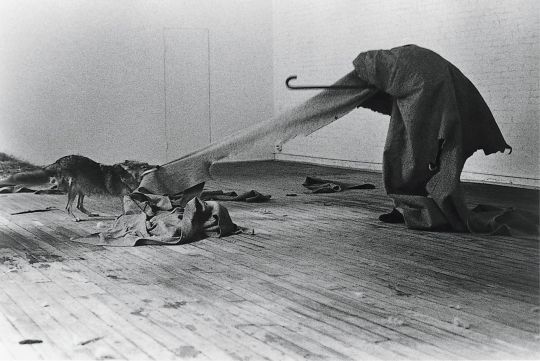
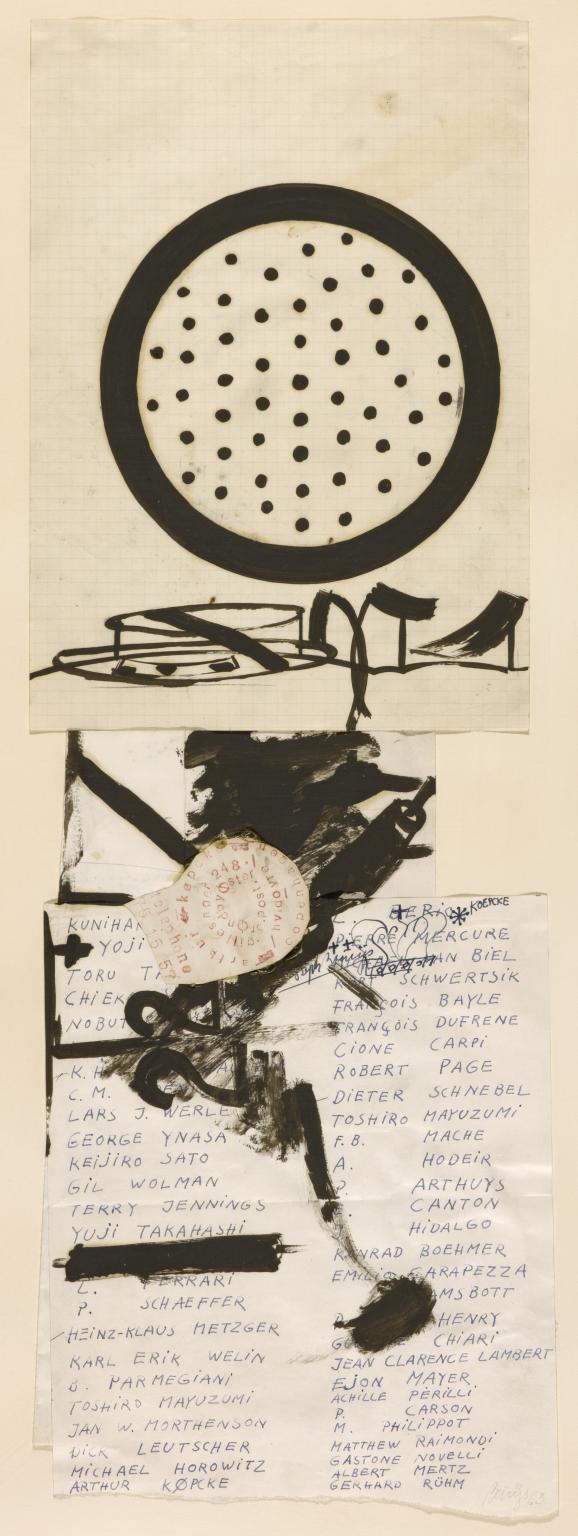
Joseph Beuys
Joseph Beuys (1921-1986) was a controversial teacher and politician, but most notably a celebrated sculptor and performance artist (Russell, 1986). Through interviews with Beuys, it has been confirmed that his artworks are autobiographical (Mesch, 2017). Perhaps his most defining life experience was when he crashed his plane in the Crimean Mountains in 1984 as a Luftwaffe pilot, and was rescued by Tatars (Russell, 1986). Beuys was wrapped up in fat and felt to prevent hypothermia, which explains why he used these materials in his later artwork- as a symbol of regeneration, warmth and safety (Russell, 1986). These were not the only unconventional mediums he used as he also experimented with incorporating animals, batteries and blackboard etc. in his artwork (Beuys and Harlan, 2007). An example of this is his 1974 performance, ‘Coyote: I like America and America likes me’. This is where he spent a week in his dealer's gallery, fenced in with a live coyote. This symbolized a healing ritual that related to the American Indians’ tradition (Russell, 1986). Beuys formulated the term ‘social sculpture’ in the 70s because he had broad view of how sculptures could be defined (Beuys and Harlan, 2007). This ‘social sculpture’ was not only meant figuratively but also literally, as he used unusual and memorable materials to make large-scale and often disconcerting three-dimensional images. Some of these sculptures were displayed at the Guggenheim Museum in 1979-80 (Russell, 1986). Beuys was a part of the Fluxus movement. His use of performance photography was different compared to the rest of the Fluxus performers, since they normally adhered to ‘concretist performance aesthetics’ (Mesch, 2017). Beuys stated that the Fluxus movement would result in new ideas that would continue to innovate and create a better connection between previously distinct areas- an evolution of art (Mesch, 2017). As well as formally exploring art theory, Beuys also enjoyed delving into politics, activism, scientific processes, theology and spirituality throughout his life.
Joseph Beuys’ ‘Fluxus Name List’ (1963) inspired my Indian ink experiments for the D&AD- Google & HMCT brief. It consisted of a combination of various mediums like printed material, ink and a handwritten listen of global artists from Europe, America and Asia, who were involved in the Fluxus movement (Mesch, 2017). The collage included different sizes of paper that overlapped in a chaotic manner, two joined plain pieces of paper rectangles, scored/torn pieces of writing paper and rough ink brush strokes (Mesch, 2017). In a similar fashion I tried to create layered compositions, combining various patterns and materials, and incorporating ink like Beuys did. I used unconventional material I had in my home like string, bamboo sticks and damaged paint brushes. His work also inspired my typography manual workbook brief, where I layered different paper cut outs and materials to create an intricate but balanced design.
References:
Beuys, J. and Harlan, V. (2007) What is Art?: Conversation with Joseph Beuys. West Sussex, Clairview Books.
Mesch, C. (2017) Joseph Beuys. London: Reaktion Books.
Russell, J. (1986). Joseph Beuys, sculptor, is dead at 64. The New York Times [online] 25 Jan. Available at: https://www.nytimes.com/1986/01/25/obituaries/joseph-beuys-sculptor-is-dead-at-64.html?auth=login-email&login=email [Accessed 25 May 2020].
1 note
·
View note